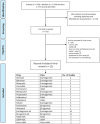Association Between β-Adrenoreceptor Agonists and Antagonists and Parkinson's Disease: Systematic Review and Meta-Analysis
- PMID: 40200766
- PMCID: PMC11979683
- DOI: 10.1002/pds.70140
Association Between β-Adrenoreceptor Agonists and Antagonists and Parkinson's Disease: Systematic Review and Meta-Analysis
Abstract
Background: β-agonists and β-antagonists are among the most prescribed drugs worldwide. In 2018, studies suggesting a harmful association between propranolol and Parkinson's disease (PD) prompted a signal procedure by the European Medicines Agency's safety committee, which concluded with no update of product information. Several studies have been published since then. We aimed to systematically review, critically appraise, and meta-analyse all studies on the association between the use of β-antagonists (including propranolol) and β-agonists, and the risk of PD.
Methods: We searched Embase and Medline up to December 2024 for observational and intervention studies that reported relative risk estimates of the association between use of these medicines and PD. Two reviewers screened the records, extracted the data, and assessed the risk of bias. The restricted maximum likelihood method was used to compute pooled effect estimates and 95% confidence intervals (CIs).
Results: Twenty-two studies were eligible. Overall, 20 had a high risk of bias in at least one domain. Twelve studies had medium to high risk of outcome misclassification. Of the 14 studies concerning β-antagonists, eleven had an unclear or high risk of protopathic bias, as propranolol is indicated for the treatment of essential tremor. Control for confounding by socio-economic status, area of residence (urban/rural), and smoking (a protective factor against PD) was deficient or lacking in 9/22, 15/22, and 12/22 studies, respectively. Lag times were applied in 9/22 studies. In meta-analysis, the summary relative risk (RR) of PD was 1.41 (95% CI: 1.18-1.68) for the class of β-antagonists (12 studies) and 0.93 (0.84-1.03) for β2-agonists (11 studies). Among specific β-antagonists, the summary RR of PD was 2.36 (1.66-3.36) for propranolol (7 studies), 0.84 (0.80-0.88) for carvedilol (3 studies) and 1.02 (0.87-1.18) for metoprolol (4 studies). For specific β2-agonists, summary RR was 0.88 (0.77-1.01) for salbutamol (7 studies), 0.91 (0.88-0.95) for short-acting β2-agonists (6 studies), and 0.85 (0.76-0.96) for long-acting β2 agonists (5 studies). Restricting to subgroups based on quality criteria resulted in weaker or non-statistically significant associations.
Conclusion: The quality and quantity of the available evidence do not support a causal association between use of β-adrenoreceptor modulators and PD. Significant associations are most likely explained by protopathic bias and confounding.
Keywords: Parkinson's disease; adrenergic beta‐agonists; adrenergic beta‐antagonists; systematic review.
© 2025 The Author(s). Pharmacoepidemiology and Drug Safety published by John Wiley & Sons Ltd.
Conflict of interest statement
The authors declare no conflicts of interest.
Figures




Similar articles
-
β2-adrenoceptor agonists and antagonists and risk of Parkinson's disease.Mov Disord. 2018 Sep;33(9):1465-1471. doi: 10.1002/mds.108. Mov Disord. 2018. PMID: 30311974
-
β-adrenoreceptors and the risk of Parkinson's disease.Lancet Neurol. 2020 Mar;19(3):247-254. doi: 10.1016/S1474-4422(19)30400-4. Epub 2020 Jan 27. Lancet Neurol. 2020. PMID: 31999942 Review.
-
β2-adrenoreceptor medications and risk of Parkinson disease.Ann Neurol. 2018 Nov;84(5):683-693. doi: 10.1002/ana.25341. Epub 2018 Oct 30. Ann Neurol. 2018. PMID: 30225948 Free PMC article.
-
The association between developing Parkinson's disease and β-Adrenoceptor acting agents use: A systematic review and meta-analysis.J Neurol Sci. 2021 Nov 15;430:120009. doi: 10.1016/j.jns.2021.120009. Epub 2021 Sep 27. J Neurol Sci. 2021. PMID: 34598055
-
Use of β2-adrenoreceptor agonist and antagonist drugs and risk of Parkinson disease.Neurology. 2019 Jul 9;93(2):e135-e142. doi: 10.1212/WNL.0000000000007694. Epub 2019 May 24. Neurology. 2019. PMID: 31127070
References
Publication types
MeSH terms
Substances
LinkOut - more resources
Full Text Sources
Medical

